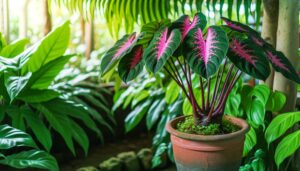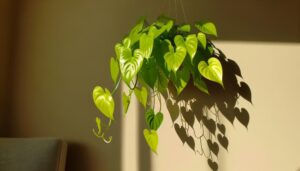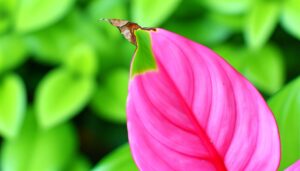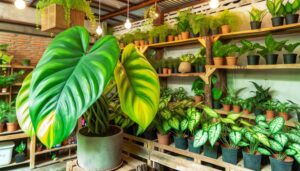What Is a Philodendron Gloriosum X Verrucosum Hybrid?
The Philodendron Gloriosum X Verrucosum hybrid is a unique cultivar resulting from the crossbreeding of Philodendron gloriosum and Philodendron verrucosum, both native to Central and South America, specifically Colombia and Ecuador. This hybrid features large, velvety, heart-shaped leaves measuring 30-40 cm, showcasing deep green hues with distinctive silver or white veins.
It exhibits a rhizomatous root system with a growth habit that can either be creeping or climbing. Best growth requires well-draining, aerated soil, bright indirect sunlight, and humidity levels between 60-80%.
Regular watering, balanced fertilization, and high-light conditions are essential. Discover intricate details on cultivation and care.
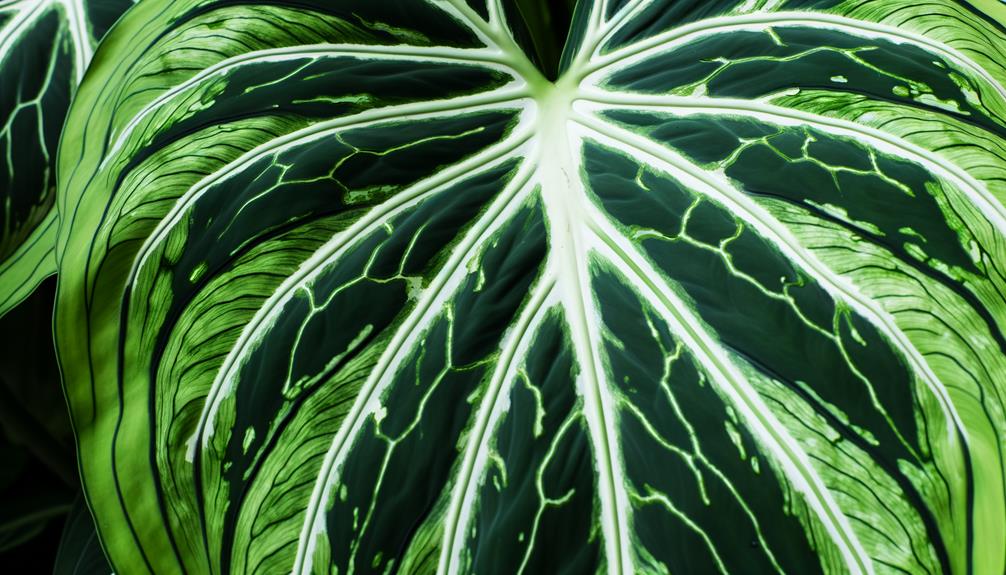
Key Takeaways
- A hybrid plant combining traits from Philodendron gloriosum and Philodendron verrucosum.
- Features large, velvety, heart-shaped leaves with deep green and silver/white veins.
- Originates from Central and South America, specifically Colombia and Ecuador.
- Requires well-draining soil, high humidity, and bright, indirect sunlight.
- Propagated through stem cuttings with nodes and aerial roots.
Origin and Background

The hybrid Philodendron Gloriosum X Verrucosum originates from crossbreeding two distinct species within the Philodendron genus, namely Philodendron gloriosum and Philodendron verrucosum, both native to the tropical rainforests of Central and South America.
Philodendron gloriosum, characterized by its creeping growth habit and velvety, heart-shaped leaves, is endemic to Colombia. Conversely, Philodendron verrucosum, known for its climbing nature and vibrant, deeply veined foliage, hails from Ecuador.
Hybridization between these species leverages their unique genetic traits, producing a specimen that amalgamates desirable characteristics from both parents. This deliberate crossbreeding aims to enhance ornamental value and adaptability, enriching the diversity within cultivated Philodendron varieties.
Consequently, the hybrid serves as a demonstration of botanical innovation and horticultural expertise.
Physical Characteristics
Often exhibiting a harmonious blend of traits from its parent species, the Philodendron Gloriosum X Verrucosum hybrid features large, velvety, heart-shaped leaves with prominent, deeply veined structures and a creeping or climbing growth habit.
The leaves, typically measuring between 30-40 cm in length, display a rich, deep green coloration, accented by silver or white venation. The adaxial leaf surface is plush and tactile, while the abaxial surface may exhibit a reddish hue, inherited from Philodendron verrucosum.
Stems (petioles) are robust, often displaying a slightly hairy texture. This hybrid's growth pattern includes a rhizomatous root system, facilitating its spread across the substrate.
The unique combination of attributes makes this hybrid a sought-after specimen for botanical enthusiasts.
Growth Requirements
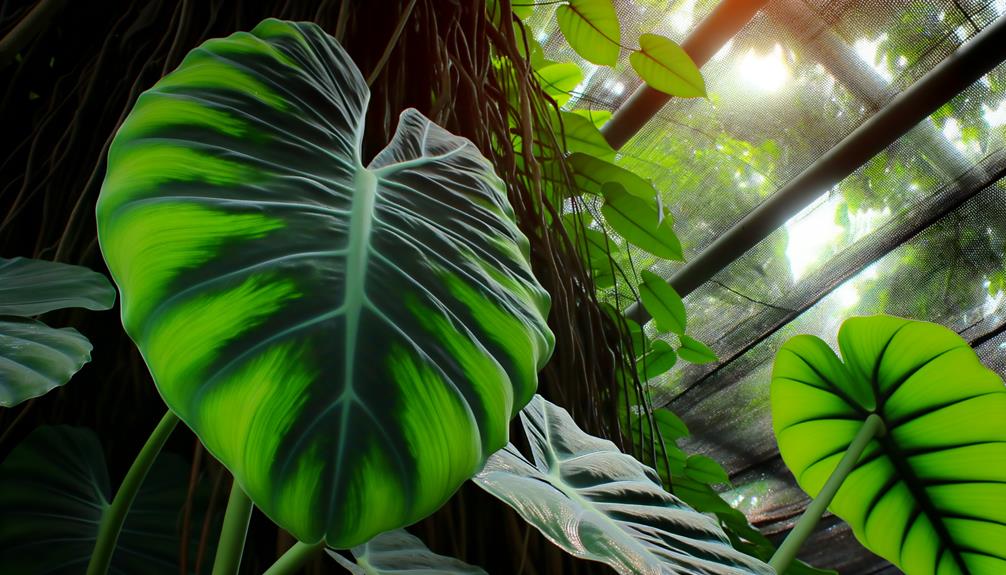
Understanding the specific growth requirements of the Philodendron Gloriosum X Verrucosum hybrid is essential for cultivating its distinctive, velvety foliage and robust structure. Ideal soil composition is necessary, requiring a well-draining, aerated medium. A blend of peat moss, perlite, and orchid bark (Sphagnum peat, Perlite, and Pine bark) provides the needed substrate characteristics.
Humidity levels should be maintained between 60-80%, as Philodendrons are epiphytic and thrive in higher moisture environments. Regular watering, ensuring the medium remains moist but not waterlogged, is vital. Fertilization with a balanced, water-soluble fertilizer (20-20-20) during the growing season supports vigorous growth.
Pruning dead or yellowing leaves and repotting biannually aligns with top horticultural practices for this hybrid.
Light and Temperature
Philodendron Gloriosum X Verrucosum hybrid thrives under bright, indirect sunlight, mimicking the dappled light of its native understory habitat.
Best temperature conditions range between 18°C to 26°C, ensuring robust growth and minimizing stress.
Seasonal care involves adjusting light exposure and humidity levels, particularly during winter months when indoor environments can become challenging.
Ideal Light Conditions
Ideal light conditions for the Philodendron Gloriosum X Verrucosum hybrid (Philodendron gloriosum x Philodendron verrucosum) involve bright, indirect sunlight, as direct exposure can scorch its delicate foliage. This hybrid thrives under filtered light, mimicking the dappled sunlight of its native understory rainforest habitat. To promote optimal growth, avoid placing the plant in direct sunlight, which can cause leaf burn and discoloration.
Key light condition tips include:
- Bright, indirect sunlight: Essential for photosynthesis without causing harm.
- East or north-facing windows: Ideal for providing the appropriate light intensity.
- Artificial grow lights: Useful for complementing natural light.
- Regular rotation: Ensures uniform light distribution.
- Shade cloth: Can help scatter excessive direct light.
Adhering to these conditions will cultivate healthy, vibrant foliage.
Temperature Range Preferences
Maintaining an ideal temperature range between 65°F and 80°F (18°C to 27°C) is crucial for the health and vigor of the Philodendron gloriosum x Philodendron verrucosum hybrid. This hybrid tropical plant thrives in stable, warm environments that mimic its native habitat. Extreme fluctuations in temperature can induce stress, leading to impaired growth or susceptibility to pathogens.
During colder months, it is essential to maintain temperatures do not drop below 60°F (15°C) to prevent chilling injury. Conversely, temperatures exceeding 85°F (29°C) may cause heat stress, particularly if coupled with low humidity. For best growth, maintain consistent warmth and avoid abrupt changes in environmental conditions, while ensuring adequate ventilation to prevent fungal infections.
Seasonal Care Tips
Seasonal care for the Philodendron gloriosum x Philodendron verrucosum hybrid requires careful attention to light strength and temperature regulation to achieve ideal growth and health. This hybrid thrives in environments that mimic its native tropical habitats. Providing diffused, indirect light is essential, as direct sunlight can scorch its delicate foliage. Best temperature ranges from 18°C to 27°C (64°F to 81°F), with a preference for higher humidity levels.
- Light Strength: Bright, indirect light to mimic understory conditions.
- Temperature Range: Maintain between 18°C to 27°C.
- Humidity: Keep humidity levels above 60%.
- Seasonal Adjustments: Reduce watering during cooler months.
- Placement: Avoid drafty areas and sudden temperature fluctuations.
These considerations promote strong growth and vibrant foliage.
Watering Needs
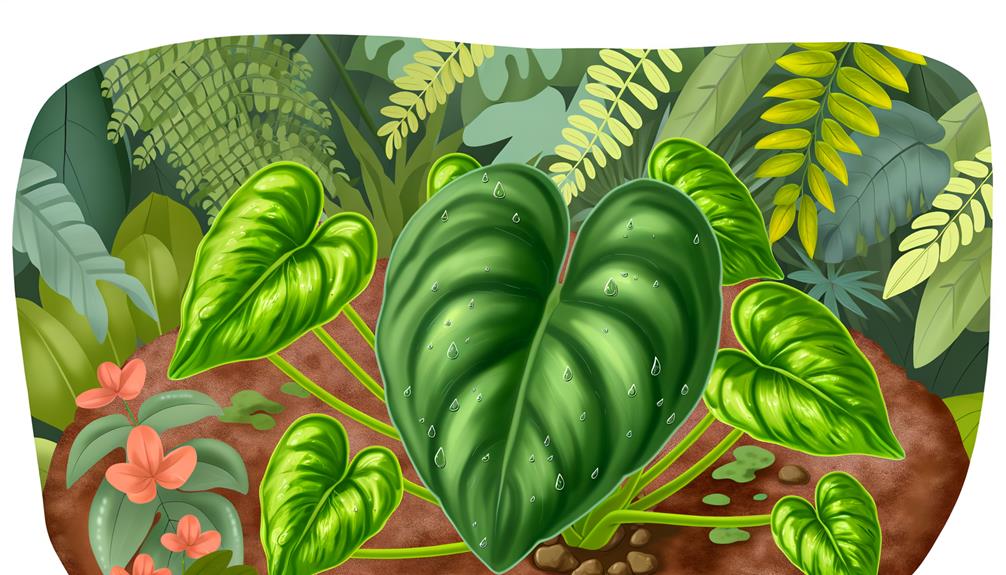
Proper hydration is necessary for the Philodendron Gloriosum X Verrucosum hybrid, requiring a balance that prevents both desiccation and waterlogging. This hybrid, combining traits from Philodendron gloriosum and Philodendron verrucosum, thrives under specific moisture conditions.
Irrigation should be executed when the top 2-3 centimeters of the substrate are dry to touch, ensuring the aroid's roots remain adequately moist but not saturated. Utilizing a well-draining potting medium is vital to avert root rot (Phytophthora spp.) and other pathogenic afflictions.
Employing a consistent watering schedule, adjusted for seasonal variations and indoor humidity levels, will support best growth. Additionally, using dechlorinated water at room temperature can prevent mineral buildup and foliage damage, aligning with the plant's natural tropical habitat requirements.
Soil and Fertilizer
To complement the precise watering schedule, the Philodendron Gloriosum X Verrucosum hybrid requires a substrate that mimics its natural epiphytic habitat, incorporating elements such as orchid bark, perlite, and peat moss to secure ideal aeration and drainage. Essential for its peak growth, this mix guarantees the roots are neither waterlogged nor parched.
For fertilization, a balanced, water-soluble fertilizer with a 20-20-20 NPK ratio, applied every other month during the growing season, suffices.
- Orchid Bark: Enhances aeration and replicates natural epiphytic conditions.
- Perlite: Enhances drainage and prevents root rot.
- Peat Moss: Retains moisture while offering acidity.
- 20-20-20 Fertilizer: Balanced nutrient supply.
- Every Other Month Application: Prevents nutrient deficiency while avoiding excessive fertilization.
This thoughtful combination ensures strong growth and lush foliage.
Common Pests and Diseases
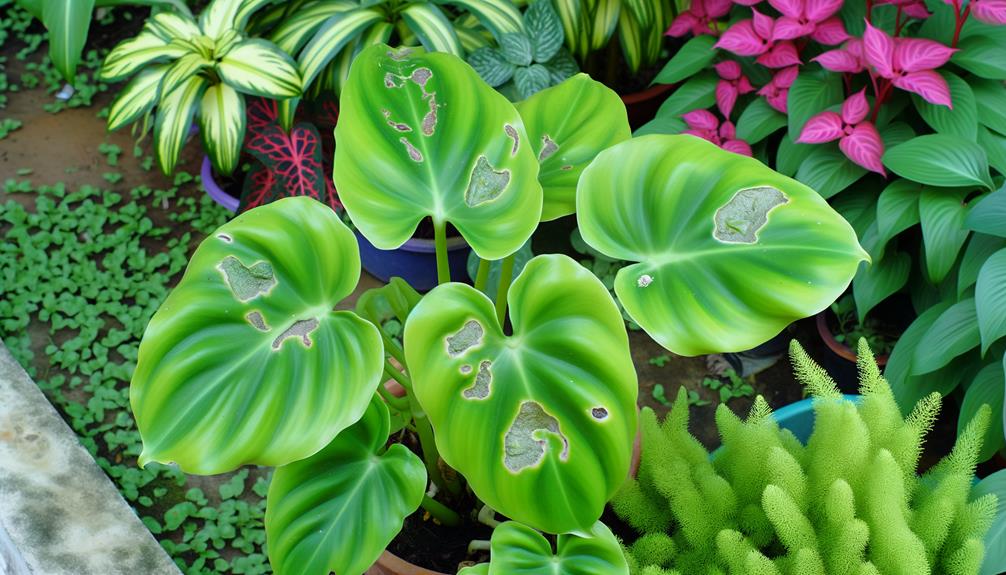
Identifying and managing common pests and diseases is vital for maintaining the health of the Philodendron Gloriosum X Verrucosum hybrid, as it is susceptible to infestations by spider mites (Tetranychus urticae), aphids (Aphidoidea spp.), and fungal infections like root rot (Phytophthora spp.) and leaf spot (Xanthomonas campestris).
Tetranychus urticae can be identified by fine webbing and chlorotic speckling on leaves. Aphidoidea spp., typically found on new growth, cause leaf curling and stunted growth. Root rot, caused by Phytophthora spp., manifests as blackened, mushy roots and wilting foliage. Xanthomonas campestris results in water-soaked lesions on leaves that turn necrotic.
Regular monitoring, appropriate cultural practices, and targeted treatments are essential for effective pest and disease management.
Propagation Methods
Propagation of the Philodendron Gloriosum X Verrucosum hybrid can be effectively achieved through stem cuttings, guaranteeing that each cutting contains at least one node and a healthy aerial root. This approach maximizes the chances of successful rooting and plant development.
To optimize propagation, consider the following techniques:
- Node Identification: Make sure the cutting includes a segment with a visible node (a point of leaf attachment).
- Aerial Roots: Select cuttings with well-developed aerial roots (radiculae) to enhance water and nutrient uptake.
- Sterilizing Tools: Use sterilized cutting instruments to prevent microbial infections.
- Humidity Control: Maintain high humidity levels around the cutting to prevent desiccation.
- Substrate Choice: Employ a well-draining substrate, such as sphagnum moss or perlite, to facilitate root growth.
These detailed steps will support successful propagation for this hybrid.
Conclusion
The Philodendron gloriosum x verrucosum hybrid harmonizes the unique characteristics of both parent species, much like a symphony of two distinct compositions.
Exhibiting striking foliage with a blend of velvety and textured leaves, this hybrid requires specific conditions for best growth. These include precise light, temperature, and moisture levels.
Proper soil composition and vigilant pest management are essential.
Propagation methods guarantee the continuation of its aesthetic appeal, making it a prized specimen in botanical collections.

